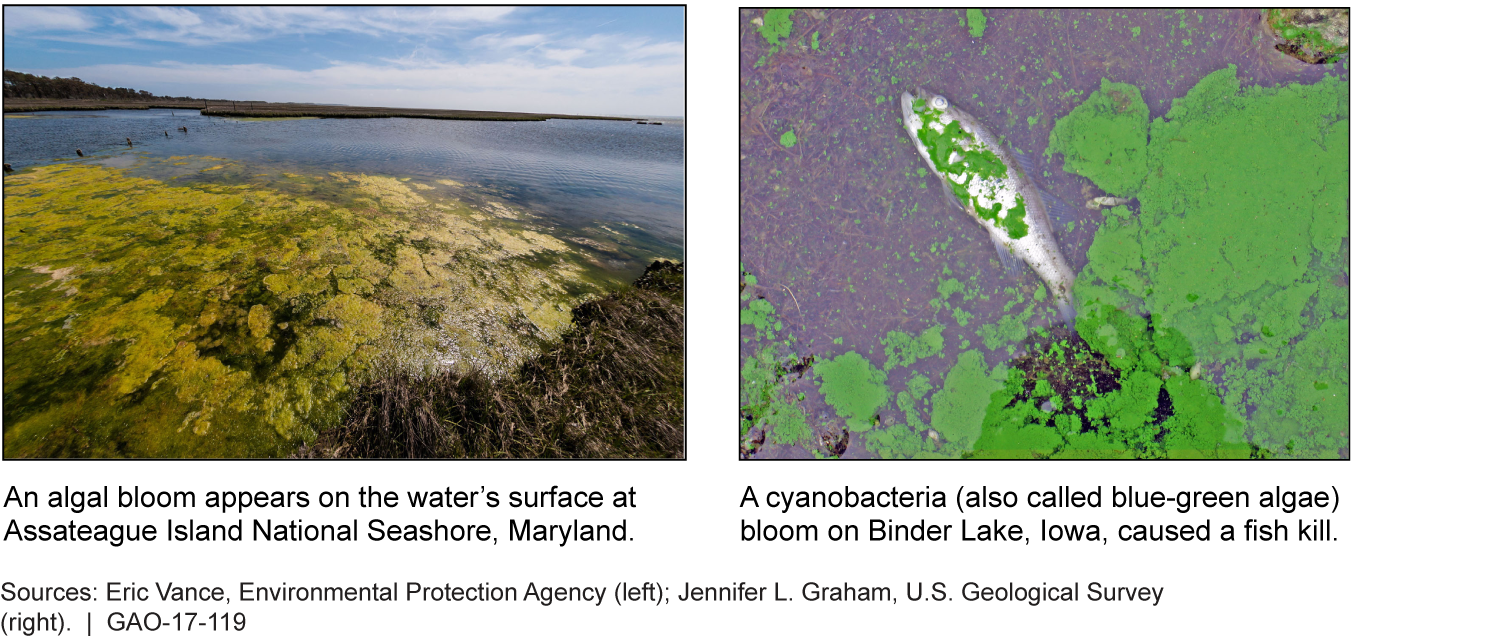Environmental Protection: Information on Federal Agencies' Expenditures and Coordination Related to Harmful Algae
Fast Facts
Harmful overgrowths of algae—called algal blooms—are a problem in all 50 states. These blooms can hurt aquatic plants and animals by producing toxins, consuming oxygen, and limiting light penetration in the water. People who eat affected seafood, drink the contaminated water, or breathe airborne droplets can get sick or even die. These blooms can also hurt the seafood industry, recreation, and tourism.
Twelve federal agencies reported spending roughly $101 million on research, monitoring, and other activities to address harmful algal blooms in fiscal years 2013-2015. Agencies coordinate in a variety of ways to share information and expertise.
Harmful Algal Blooms Can Have Toxic Effects on the Environment and Aquatic Species

Two pictures of algal blooms, one in Maryland and one in Iowa.
Highlights
What GAO Found
Twelve federal agencies reported expending an estimated total of roughly $101 million from fiscal years 2013 through 2015 to fund various research, monitoring, and other activities related to harmful algae—overgrowths of algae that can create toxic “blooms” in marine or freshwater environments. The agencies provided a mix of actual and estimated expenditure data and used different methods for collecting the data, making comparisons among agencies, and a federal total, inexact. Based on the data, the 5 agencies with the largest expenditures related to harmful algal blooms for this period—totaling roughly $86 million—were the National Oceanic and Atmospheric Administration, $39.4 million; National Science Foundation (NSF), $15.4 million; Environmental Protection Agency (EPA), $14.5 million; U.S. Geological Survey, $9 million; and the National Institute of Environmental Health Sciences (NIEHS), $8 million. According to agency officials, these 5 agencies funded efforts to research and analyze harmful algal blooms; forecast, monitor, and respond to their occurrence; and investigate human and ecological health effects. In addition, other agencies expended millions of dollars funding activities to address harmful algae. For example, from fiscal years 2013 through 2015, the National Aeronautics and Space Administration reported expending nearly $2 million on research to improve the detection of algal blooms using satellite imagery.
Federal officials reported that their agencies coordinate in a variety of ways with each other and with nonfederal stakeholders to share information, expertise, and opportunities for collaboration on activities to address harmful algae. For example, since 2014, an interagency working group has been the primary, government-wide mechanism through which federal agencies coordinate such activities, develop plans for future work, and identify any gaps in federal activities and capabilities. In addition, federal officials reported that agencies participate in numerous groups, task forces, and other coordination efforts led by federal agencies, states, international organizations, or academics. Furthermore, federal officials reported a number of interagency partnerships directly related to their harmful algae work, such as NIEHS' and NSF's collaboration since 2005 to jointly fund research projects.
Harmful Algal Blooms Can Have Toxic Effects on the Environment and Aquatic Species

Why GAO Did This Study
Harmful algal blooms are an environmental problem in all 50 states, according to EPA. While algae are essential to the ecosystem, providing food for all types of animals, these blooms can produce toxins that hurt the environment and local economies. Specifically, they can cause human illness or death from the consumption of seafood or water contaminated by toxic algae; harm aquatic and other animal species through neurological or liver damage or severe oxygen depletion; and hurt the seafood industry, recreation, and tourism. Harmful algal blooms occur naturally, but their prevalence, frequency, and severity are increasing—and this increase is influenced by climate, pollution, and human activities such as agriculture and wastewater, according to an interagency working group report.
The Drinking Water Protection Act included a provision for GAO to review federally funded activities related to harmful algal blooms. This report examines (1) how much federal agencies expended on these activities from fiscal years 2013 through 2015 and (2) how federal agencies coordinate their activities with each other and with nonfederal stakeholders. GAO collected information from federal agencies by using a questionnaire and interviewing agency officials.
GAO provided a draft of this report to the Departments of Agriculture, Commerce, Defense, Health and Human Services, and the Interior; EPA; NASA; and the Executive Office of the President for comment. Most of the agencies provided technical comments, which were incorporated as appropriate.
For more information, contact J. Alfredo Gómez at (202) 512-3841 or gomezj@gao.gov.
